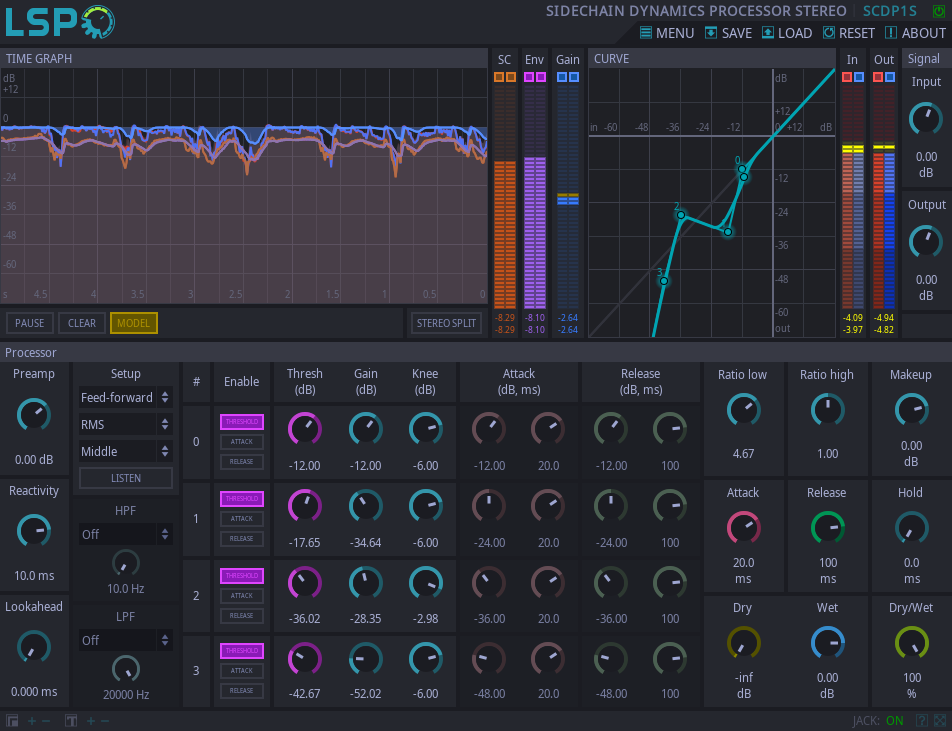Sidechain Dynamics Processor Stereo

Detailed: LSP Sidechain Dynamics Processor Stereo (SCDP1S)
Formats: CLAP, JACK, LADSPA, LV2, VST2, VST3
Categories: Dynamics
Developer: Vladimir Sadovnikov
Description:
This plugin performs dynamic processing of stereo input signal. Flexible sidechain-control configuration and additional sidechain inputs are provided. There are possible different variants of dynamic processor to build: compressor, limiter, gate, expander, some kind of transient designer and many others due to possibility of flexible dynamic curve configuration. Also dynamic range can be split into sub-ranges that may have their individual attack and release timings.
Additionally, Stereo split mode allows to apply processing to the left and right channels independently while keeping the same settings for the left and right channels.
Controls:
- Bypass - bypass switch, when turned on (led indicator is shining), the plugin bypasses signal.
- Pause - pauses any updates of the time graph.
- Clear - clears all graphs.
- Stereo Split - enables independent processing of left and right channels.
- Gain L, R - enables drawing of gain amplification line and corresponding amplification meter.
- SC L, R - enables drawing of sidechain input graph and corresponding level meter.
- Env L, R - enables drawing of envelope graph and corresponding level meter.
- In L, R - enables drawing of input signal graph and corresponding level meter.
- Out L, R - enables drawing of output signal graph and corresponding level meter.
- Link - the name of the shared memory link to pass sidechain signal.
- Pre-mix - shows pre-mix control overlay.
- Sidechain - shows the sidechain control overlay.
- Mix - shows the Dry/Wet control overlay.
'Processor' section:
- Ratio low - compression/expansion ratio below the lowest-threshold knee.
- Ratio high - compression/expansion ratio after the highest-threshold knee.
- Attack - default attack time used on the whole dynamics range.
- Release - default release time used on the whole dynamics range.
- Hold - the time period the envelope holds it's maximum value before starting the release.
- Makeup - additional amplification gain after dynamic processing stage.
- Ranges - allows to configure up to four additional knees, attack and release ranges:
- Thr - Knob that enables additional knee.
- Att - Knob that enables additional attack range.
- Rel - Knob that enables additional release range.
- Thresh - Threshold of the additional knee, works only if corresponding Thr button is turned on.
- Gain - Gain of the additional knee, works only if corresponding Thr button is turned on.
- Knee - Softness of the knee, works only if corresponding Thr button is turned on.
- Attack - Pair of knobs that allows to adjust the attack threshold and attack time of the additional attack range. The new attack time is applied if the envelope is over the specified threshold. Otherwise the attack time of previous range or default attack time (if there is no previous range) will be applied.
- Release - Pair of knobs that allows to adjust the release threshold and release time of the additional release range. The new release time is applied if the envelope is over the specified threshold. Otherwise the release time of previous range or default release time (if there is no previous range) will be applied.
'Signal' section:
- Input - overall input gain.
- Output - overall output gain.
Pre-mix control overlay:
- In -> SC - the amount of signal from input channel added to the Sidechain.
- In -> Link - the amount of signal from input channel added to the shared memory link.
- SC -> In - the amount of signal from sidechain input channel added to the input channel.
- SC -> Link - the amount of signal from sidechain input channel added to the shared memory link.
- Link -> In - the amount of signal from shared memory link added to the input channel.
- Link -> SC - the amount of signal from shared memory link added to the sidechain channel.
Sidechain control overlay:
- Listen - allows to listen the signal processed by sidechain.
- Type - set of combo boxes that allow to control type, position and source of sidechain. Available types are:
- Feed-forward - sidechain input is connected to processor's input. More aggressive compression.
- Feed-back - sidechain input is connected to processor's output. Vintage-style more accurate compression.
- External - sidechain signal is taken from additional (external) sidechain inputs of plugin.
- Link - sidechain input is passed by shared memory link.
- Peak - peak mode.
- RMS - Root Mean Square (SMA) of the input signal.
- LPF - input signal processed by recursive 1-pole Low-Pass Filter (LPF).
- SMA - input signal processed by Simple Moving Average (SMA) filter.
- Middle - middle part of signal is used for sidechain processing.
- Side - side part of signal is used for sidechain processing.
- Left - only left channel is used for sidechain processing.
- Right - only right channel is used for sidechain processing.
- Min - the absolute minimum value is taken from stereo input.
- Max - the absolute maximum value is taken from stereo input.
- Left/Right - left and right channels are being processed using respectively the left and right sidechain channels in stereo split mode.
- Right/Left - left and right channels are being processed using respectively the right and left sidechain channels in stereo split mode.
- Mid/Side - left and right channels are being processed using respectively the middle and side parts of sidechain signal in stereo split mode.
- Side/Mid - left and right channels are being processed using respectively the side and middle parts of sidechain signal in stereo split mode.
- Preamp - pre-amplification of the sidechain signal.
- Reactivity - reactivity of the sidechain signal.
- Lookahead - look-ahead time of the sidechain relative to the input signal.
- LPF - allows to set up slope and cut-off frequency for the low-pass filter applied to sidechain signal.
- HPF - allows to set up slope and cut-off frequency for the high-pass filter applied to sidechain signal.
Dry/Wet mix control overlay:
- Mix Dry - the amount of dry (unprocessed) signal.
- Mix Wet - the amount of wet (processed) signal.
- Mix Dry/Wet - the knob that controls this balance between mixed dry and wet signal (see Mix Dry and Mix Wet) and the dry (unprocessed) signal.































